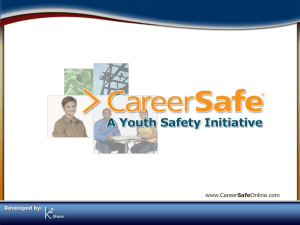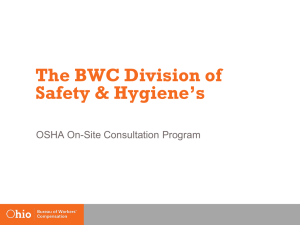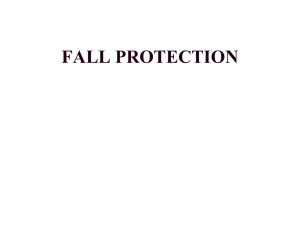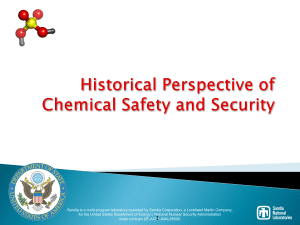Session 8 - Risk Management
advertisement
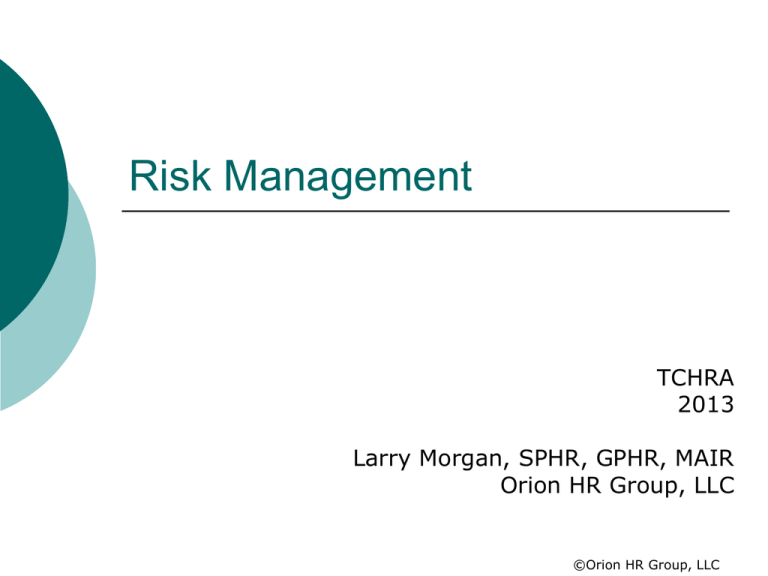
Risk Management TCHRA 2013 Larry Morgan, SPHR, GPHR, MAIR Orion HR Group, LLC ©Orion HR Group, LLC PHR / SPHR Exam 8% of exam for PHR 7% of exam for SPHR Questions tend to be easier in this module We’ll cover items most likely to be on exam What areas are covered in this module? Six sections Organizational Risk Key Legislation Safety Health Security Privacy What is Risk Management? It is the chance that something will happen, positively or negatively, that will affect business goals and objectives. It is the use of insurance and other strategies in an effort to prevent or minimize an organization’s exposure to liability in the event a loss or injury occurs. Risk management techniques Assess Risk Evaluate / modify systems Monitor Efforts Develop Systems Implement Programs Operational Risk includes: Personnel risk Physical assets Technology Relationships External/regulatory Types of situations Worker injury and safety Violence Fraud Theft Lawsuits Natural disaster / business continuity Pandemic PC Virus Addressing Risk Analysis Conduct audit to assess security risk factors (vulnerabilities) Four categories Virtually certain Highly probable Moderately probable Improbable Risk analysis, continued Assess against impact or cost Cost to permanently replace lost or damaged assets Cost to temporarily replace lost or damaged assets Cost of related losses caused by the inability to carry on normal activities Cost of loss of investment income from short term expenses incurred to meet these costs Severity of impact placed in four levels Level Level Level Level 1 2 3 4 – – – – Fatal to the organization Very serious Moderately serious Not serious or negligible Why should HR Care? Examine HR policies / procedures to determine organization risks Provide a safe work environment Understand and minimize / eliminate risk Collaborate with other functional areas Monitor compliance with laws and regulations Communicate policies and procedures Provide risk mgmt training programs Evaluate the effectiveness of programs HR role Handling “people” risks Staffing Personnel policies Insurance polices (workers comp, unemployment comp, disability, health care) Access issues to facilities and technology Training Compliance and regulatory Safety Risk assessment Disaster recovery HR and Staffing Cannot ask potential employees about workers comp claims, accidents, etc. Questions regarding criminal activities must be job related and based on convictions, not arrests ADA issues Job description and essential functions Identify physical requirements Due diligence regarding negligent hiring and negligent retention Contingent offer must be made before medical testing (drug, physical exam, blood pressure, etc) Testing must be job related and validated After contingent offer, you may ask about workers comp, disabilities, etc. OSHA Background Following several major industrialized accidents including fire and mine explosion No state standards OSHA created in 1970 to standardize reporting and create federal agency to regulate safety Mission is to enact and enforce federal safety regulations Uses “carrot and stick” approach Able to inspect and issue citations and fines Track data Key legislation in Risk Management Mine Safety and Health Act Drug free workplace act USA Patriot Act Homeland Security Act Americans with Disabilities Act Fair Labor Standards Act OSHA Electronic Communications Privacy Act Genetic Information Nondiscrimination Act (GINA) Cause of Accidents 20% of injuries are caused by unsafe conditions 80% of injuries are caused by unsafe acts OSHA General Duty Clause Organizations have “a general duty to provide a workplace that is free from ‘recognized hazards’ that are likely to cause death or severe physical harm”. OSHA Rights The right to demand safety and health on the job The right to demand inspections The right to have an authorized employee representative accompany an inspection The right to file a complaint The right to be informed of workplace hazards The right to receive training Key OSHA standards OSHA has six volumes of standards in the Code of Federal Regulations (CFR) Four major categories General industry Maritime Construction Agriculture Mining industry covered under Mine Safety and Health Act OSHA Standards Emergency exit standards Occupational noise exposure Machine guarding Personal protective equipment Process safety management Hazard communication Control of hazardous energy Confined space entry Bloodborne pathogens Hazard Communication Standard Employees must be informed if working with hazardous materials Must be trained at time they are assigned Audiovisual, classroom, interactive Material Safety Data Sheets Additional training may be required What is “lockout/tagout”? Equipment that is being serviced or not functioning properly should be: “deenergized” Isolated from energy sources Locked or tagged If “lockable”, it is locked out and unusable A “tagout” is a “do not use” or “out of service” label on the machine What is meant by confined space? Areas with unique physical hazards Includes manholes, sewers, tunnels Hazards include: Excessive heat Insufficient oxygen or too much oxygen Toxic or flammable gasses Danger of being trapped Special OSHA regulations apply What is meant by Sick Building Syndrome? Employees get acute illness for no apparent reason Possible causes: Stress Inadequate ventilation Chemical contaminants from internal causes Chemical contaminants from external causes Biological causes Investigate cause Air sampling Bloodborne pathogens Needlestick Safety and Prevention Act of 2000 Microorganisms found in human blood that can cause disease such as HIV, AIDS, Hepatitis B If at least one employee may be exposed to potentially infectious materials in the course of duties, there must be: Written exposure control plan Employee protection Employee training Offer occupationally exposed employees the hepatitis B vaccine Use safer devices Tracking log of all needlesticks, not just those that actually lead to disease Maintain privacy of employee who suffer needlesticks OSHA record keeping requirements Employers with more than 10 employees must report all employee occupational injury and illness data Occupational injury Occupational illness Recording criteria Employers are required to record work related illness and injury if they result in: Death Days away from work Restricted work or transfer to another job Loss of consciousness Diagnosis of a significant injury/illness by a physician or other licensed health care professional Medical treatment beyond first aid OSHA Forms Form 300: Log of work-related injuries and illnesses Form 300A: Summary of work related injuries and illnesses Form 301: Injury and illness incident report For information, go to: www.osha.gov/recordkeeping/new-osha300form1-1-04.pdf OSHA Form 300 OSHA Form 300A OSHA Form 301 Incidence rates Recordable incident rate Example DART (Days away/restricted or transfer rate) Example Recordable Incident Calculation Axeman Company Example Number of OSHA Recordable Cases (15) x 200,000 Number of Employee Labor Hours Worked (400,000) = Incidence rate of 7.5 Days Away / Restricted or Transfer (DART) Rate Calculation Slippery Fred’s Company Example Number of DART incidents (10) x 200,000 Number of Employee Hours Worked (400,000) = DART rate of 5 OSHA Inspections and priorities First priority- imminent danger Second priority – Catastrophes and fatal accidents Third priority – Employee complaints Fourth priority – Referrals Fifth priority - Follow-ups Sixth priority – Planned Investigations and high hazard industries Question An employee calls OSHA complaining of a problem with scaffolding on a multi story worksite in which workers could fall and seriously injure themselves. What priority would this have: a) First b) Second c) Third d) None, the employer must call Inspection procedures Opening conference Physical inspection Closing conference Question OSHA representatives show up and demand an inspection. The employer demands a search warrant before allowing them on premises. How is this handled? The employer has no right to request a search warrant If OSHA has police present, there is no need for a warrant OSHA and leave and return with a warrant OSHA will levy additional fines for the delay Violations and penalties Five levels Willful Serious Other than serious Repeat De minimus Citations Other safety issues Safety programs Definitions Incident Safety hazard Priorities First priority – eliminate hazard completely Second priority – use safeguards Third priority – use warning signs Fourth priority – train and instruct Fifth priority – Provide personal protection Safety committees Clear purpose Focus is on prevention and awareness Electromation case Group recognition with tangible rewards Educate on safe work habits Plant safety scorecards Accident scene priorities 1. 2. 3. 4. 5. Arrive safely and take charge, evaluate the situation, care for the injured, protect others from injury Protect the mishap site, keep management informed, contact appropriate state and federal officials Control crowds and traffic, take photos or make sketches, hold witnesses together, erect barriers Gather samples of evidence, label samples, take measurements, identify photos and sketches, identify witnesses by name and contact info Interview in a quiet, neutral setting; tell witnesses the purpose of the interview; let witnesses tell their story; take notes; avoid leading questions, be neutral Accident investigation An accident is an undesired event that results in physical harm to a person or damage to property Learn why the accident occurred Investigate the scene of the accident Interview the injured employee, supervisor and witnesses Complete the accident investigation report Make changes that will prevent future accidents Communicate with the employee Ergonomics Proper design of work environment to address the physical demands experienced by employees Assess physiological factors and psychological factors Methods Ergonomic team Work site analysis Redesign of job Workplace surveys Training Onsite exercise programs Monitor Ergonomic issues Musculoskeletal Disorders (MSD) Repetitive motion injuries such as Carpal Tunnel Syndrome Tendonitis Bursitis Video Display Terminals Lower back strains Sick building syndrome Modified duty programs Ergonomic problems The method used or required to do the job The effort or strength required to do the job The location or position of parts, equipment, or tools The speed or frequency of the work The duration or repetition of the tasks The design of the parts, equipment or tools Ergonomic issues Administrative or Engineering? Administrative Lack of recovery time between shifts Excessive overtime Insufficient breaks Stressful work organizations Increase in production demands Inadequate training Engineering Outmoded equipment design Inadequate seating or positioning Improper alignment or setup Physical risk factors Repetitive motion Rapid hand and wrist movement Awkward posture or seating Heavy lifting Hand arm vibration VDT- improper alignment of computer screens Employee self modification of work space Question The VP of HR for a software company is concerned over the incidence of carpal tunnel syndrome and has asked for your help in addressing the issue. What are possible courses of action? Health issues Infectious diseases HIV AIDS Hepatitis B and C Tuberculosis Pandemics Environmental health Physical (heat, noise, vibration, air conditioning, radiation, ventilation, smoking, sanitary conditions, drinking water, workplace design) Chemical (dust, fumes, gases, toxic materials, toxic chemicals, carcinogens, smoke) Biological (bacteria, fungi, insects) Employee assistance programs In house or outside contractors Services are generally 24/7 Alcohol and drug abuse counseling Emotional counseling Family and marital counseling Legal counseling Financial counseling Career counseling Workplace violence counseling Referrals Management support Employee wellness and fitness programs Flu shots First aid and CPR training Health risk assessments Health fairs Wellness / exercise / physical fitness Nutrition education High blood pressure control Weight control Stress reduction Smoking cessation Drug testing Drug free workplace act Department of transportation When do you test? Pre-employment Random Post accident Post treatment Annual or periodic Reasonable suspicion and for cause Types of drug testing Blood Urine Saliva Hair Breath alcohol Intervention strategies Constructive confrontation Counseling Referral ADA and drug use Workplace Security Fire Industrial sabotage Trespassing Employee theft Executive kidnapping Theft/sabotage of classified information Violence Terrorism Security measures Guards Identification and control systems Structural barriers Security hardware Surveillance and monitoring Question An organization is conducting layoffs with several staff. What steps may be taken to reduce risk of violence or litigation? Theft and fraud Inventory counts Fraud hotlines Sound auditing procedures Video surveillance Dollar limit authority Checks and balances Internal financial procedures Controls for audit and access Use of polygraph and other mechanical/ electrical devices Emergency response plan Natural disaster Flood Fire Tornado Earthquake Volcanic eruption Human disaster Civil disaster Labor disturbance Chemical/gas leak Explosion Blackout Brownout Workplace violence Pandemic Mandated vs. Voluntary plans OSHA mandates employers who store, manufacture, or use highly toxic chemicals, toxins or reactive materials to have emergency response plans and training to employees FEMA has sample emergency plans on their website American Red Cross Purchase or develop plans Key steps in plan Must be customized Involve senior management Create a team Identify coordinators Have plans offsite Clear priorities Protect life Eliminate risk of injury Save assets Minimize loss Resume normal operations as quickly as possible Identify resources Communicate the plan Test the plan Keep the plan current Workplace violence Causes Warning signs HR response Workplace privacy Protection of proprietary information and trade secrets Technology security risk Identify theft and Red Flag rules HITECH regulations Monitoring employees Workstation / Network Database / Software Hackers / virus Electronic Communications Privacy Act European Union Data Privacy Provide training to employees Whistleblowing Now required for SOX companies Identify clear process and policy Allow anonymous reporting Develop investigative process Communicate to employees Take prompt action Provide appeals process No reprisals Liability Insurance Employment Practices Liability Insurance (EPLI) Professional liability Professional liability insurance E&O D&O Fiduciary status of HR Corporate governance Question What type of insurance would mitigate claims of negligence in performance of professional services by managers? Workers compensation Covered in other areas of course State program, not federal Covers job related injury and illness Medical expenses and lost wages May be self insured or fully insured Rates based on occupation, employee demographics and experience Genetic Information Nondiscrimination Act (GINA) Prohibits employment action based on genetic factors Caution Pre-employment physicals and questionnaires Wellness programs Personnel file contents HIPAA and PHI / ePHI information Key terms- know these! Acquired immune deficiency syndrome (AIDS) Bloodborne pathogen Building related illness Business continuity planning Computer vision syndrome Confined space entry Cumulative trauma disorders (CTD) De minimis violation D&O coverage Disaster recovery plan Drug free workplace act Early return to work program Emergency exit procedures (means of egress standard) Employee Assistance Program Employment practices liability insurance Enterprise risk management (ERM) Ergonomics Errors and Omissions (E&O) insurance Fetal protection policies General duty clause GINA Hazard Hazard communication standard (employee right to know) Homeland Security Act Human Immunodeficiency Virus (HIV) Incident Job burnout Lockout Machine guarding standard Material Safety Data Sheets (MSDS) Mine Safety and Health Act Modified duty program Musculoskeletal disorder (MSD) National Institute for Occupational Safety and Health (NIOSH) Needlestick Safety and Prevention Act Occupational illness Occupational injury Occupational Noise Exposure (hearing conservation) standard Occupational Safety and Health Act (OSHA) Occupational Safety and Health Administration (OSHA) Occupational Safety and Health Review Commission (OSHRC) OSHA Form 300 OSHA Form 300A OSHA Form 301 Other than serious violation Pandemic Personal Protective Equipment Standard Process Safety Management Standard Professional liability insurance Proprietary information Repeat violation Risk management Risk management scorecard Safety committee Serious violation Sick building syndrome (SBS) Tagout Unsafe acts Unsafe conditions USA Patriot Act Voluntary protection program Vulnerabilities Wellness program Willful violation Sample Quiz questions Question 1 An employee does not use hearing protection required for the job. This is an example of: a) b) c) d) An unsafe condition An unsafe act A willful violation The Darwin effect Question 2 Communication to employees about toxic substances they may be exposed to is required by: a) b) c) d) ADA GINA Hazard communication standard Workers compensation carrier Question 3 Return to work programs require injured employees: a) b) c) d) Return to work with less strenuous jobs on a permanent basis Refrain from FMLA until they are medically clear to return to work To stay away until fully clearly to perform all duties Perform jobs that accommodate current limitations Question 4 The top OSHA priority for investigations is: a) b) c) d) Employee death Employee complaints High risk industries Hazardous situations Question 5 Which OSHA form must be posted by February 1 of each year: a) b) c) d) OSHA OSHA OSHA OSHA Form Form Form Form EEO-1 300 300A 301 Question 6 Which role should a safety committee play at work: a) b) c) d) Train employees Investigate accidents Record annual accident rates All of the above Question 7 Reducing the chance of infection in the workplace can be accomplished through all of the following EXCEPT: a) b) c) d) Education including frequent handwashing Strong disciplinary action Effective absence management programs to encourage staying home when ill Protective clothing Question 8 A two year employee with no history of problems or discipline becomes moody and has absence and quality problems. In meeting with the employee, the supervisor learns that the employee is having financial problems. The employer should: a) Ignore the work behavior b) Drug test the employee c) Refer the employee to employee assistance program d) Discipline the employee Question 9 A major component of a security risk analysis is to: a) b) c) d) Identify potential problem employees Determine the cost ratio of loss to expense Determine the risk factors Determine the cost of lost or damaged goods Question 10 A primary cause of employee violence is: a) b) c) d) Poorly handled terminations Working in high crime areas Working with the general public Guarding expensive or valuable property Your questions? Larry Morgan 952-210-0742 larry.morgan@orionhr.com www.orionhr.com


